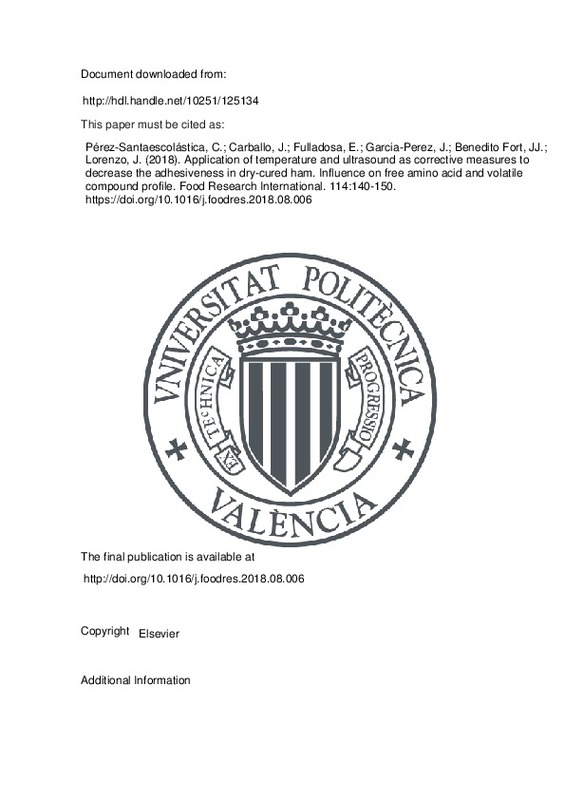JavaScript is disabled for your browser. Some features of this site may not work without it.
Buscar en RiuNet
Listar
Mi cuenta
Estadísticas
Ayuda RiuNet
Admin. UPV
Application of temperature and ultrasound as corrective measures to decrease the adhesiveness in dry-cured ham. Influence on free amino acid and volatile compound profile
Mostrar el registro sencillo del ítem
Ficheros en el ítem
| dc.contributor.author | Pérez-Santaescolástica, C.
|
es_ES |
| dc.contributor.author | Carballo, J.
|
es_ES |
| dc.contributor.author | Fulladosa, E.
|
es_ES |
| dc.contributor.author | Garcia-Perez, J.V.
|
es_ES |
| dc.contributor.author | Benedito Fort, José Javier
|
es_ES |
| dc.contributor.author | Lorenzo, J.M
|
es_ES |
| dc.date.accessioned | 2019-09-05T20:05:41Z | |
| dc.date.available | 2019-09-05T20:05:41Z | |
| dc.date.issued | 2018 | es_ES |
| dc.identifier.issn | 0963-9969 | es_ES |
| dc.identifier.uri | http://hdl.handle.net/10251/125134 | |
| dc.description.abstract | [EN] The impact of low temperattire treatment and its combination with ultrasound has been evaluated in order to correct texture defects in dry-cured hams. A total of 26 dry-cured hams, classified as high proteolysis index (PI > 36%), were used. From these hams, ten slices from each ham sample were cut, vacuum packed and submitted to three different treatments: control (without treatment), conventional thermal treatments (CV) and thermal treatment assisted by power ultrasound (US). The impact of these treatments on instrumental adhesiveness, free amino acid and volatile compounds profile were assessed. Statistical analysis showed that both US and CV treatments, significantly (P<.001) decreased the instrumental adhesiveness of dry-cured hams from 85.27 g for CO to 40.59 and 38.68 g for US and CV groups, respectively. The total free amino acid content was significantly (P<.001) affected by both treatments, presenting higher values the samples from the US group (6691.5 vs. 6067.5 vs. 5278.2 mg/100 g dry matter for US, CV and CO groups, respectively). No significant differences were observed between US and CV treatments. All the individual free amino acids were influenced by ultrasound and temperature treatments, showing the highest content in sliced dry-cured ham submitted to ultrasounds at 50 degrees C, except for isoleucine which presented the highest level in samples from CV group. Similarly, significant differences (P<.05) were also detected in the total volatile compound content between CO and US groups, with a higher concentration in the CO batch (56,662.84 AU x 10(3)/g of dry-cured ham) than in the US treatment (45,848.47 AU x 10(3)/g of dry-cured ham), being the values in the CV treatment intermediate (48,497.25 AU x 10(3)/g of dry-cured ham). Aldehydes, ethers and esters, carboxylic acids and sulphur compounds were more abundant in the CO group, while CV group showed higher concentrations of ketones, alcohols and nitrogen compounds. | es_ES |
| dc.description.sponsorship | This research was supported by Grant RTA 2013-00030-CO3-03 from INIA (Spain). Acknowledgements to INIA for granting Cristina Perez Santaescolastica with a predoctoral scholarship (grant number CPD2015-0212). Jose M. Lorenzo is member of the MARCARNE network, funded by CYTED (ref. 116RT0503). | es_ES |
| dc.language | Inglés | es_ES |
| dc.publisher | Elsevier | es_ES |
| dc.relation.ispartof | Food Research International | es_ES |
| dc.rights | Reconocimiento - No comercial - Sin obra derivada (by-nc-nd) | es_ES |
| dc.subject | Adhesiveness | es_ES |
| dc.subject | Dry-cured ham | es_ES |
| dc.subject | Free amino acid content | es_ES |
| dc.subject | Heat treatment | es_ES |
| dc.subject | Proteolysis | es_ES |
| dc.subject | Ultrasound treatment | es_ES |
| dc.subject | Volatile compounds | es_ES |
| dc.subject.classification | TECNOLOGIA DE ALIMENTOS | es_ES |
| dc.title | Application of temperature and ultrasound as corrective measures to decrease the adhesiveness in dry-cured ham. Influence on free amino acid and volatile compound profile | es_ES |
| dc.type | Artículo | es_ES |
| dc.identifier.doi | 10.1016/j.foodres.2018.08.006 | es_ES |
| dc.relation.projectID | info:eu-repo/grantAgreement/MINECO//RTA2013-00030-C03-02/ES/Caracterización y detección objetiva de defectos de textura en jamón curado mediante tecnologías no destructivas. Desarrollo y evaluación de medidas correctoras/ | es_ES |
| dc.relation.projectID | info:eu-repo/grantAgreement/INIA//CPD2015-0212/ | |
| dc.relation.projectID | info:eu-repo/grantAgreement/CYTED//116RT0503//MARCAS DE CALIDAD DE CARNE Y PRODUCTOS CARNICOS IBEROAMERICANOS/MARCARNE/ | |
| dc.rights.accessRights | Abierto | es_ES |
| dc.contributor.affiliation | Universitat Politècnica de València. Departamento de Tecnología de Alimentos - Departament de Tecnologia d'Aliments | es_ES |
| dc.description.bibliographicCitation | Pérez-Santaescolástica, C.; Carballo, J.; Fulladosa, E.; Garcia-Perez, J.; Benedito Fort, JJ.; Lorenzo, J. (2018). Application of temperature and ultrasound as corrective measures to decrease the adhesiveness in dry-cured ham. Influence on free amino acid and volatile compound profile. Food Research International. 114:140-150. https://doi.org/10.1016/j.foodres.2018.08.006 | es_ES |
| dc.description.accrualMethod | S | es_ES |
| dc.relation.publisherversion | http://doi.org/10.1016/j.foodres.2018.08.006 | es_ES |
| dc.description.upvformatpinicio | 140 | es_ES |
| dc.description.upvformatpfin | 150 | es_ES |
| dc.type.version | info:eu-repo/semantics/publishedVersion | es_ES |
| dc.description.volume | 114 | es_ES |
| dc.identifier.pmid | 30361010 | |
| dc.relation.pasarela | S\379102 | es_ES |
| dc.contributor.funder | CYTED Ciencia y Tecnología para el Desarrollo | |
| dc.contributor.funder | Ministerio de Economía y Competitividad | es_ES |







![[Cerrado]](/themes/UPV/images/candado.png)

